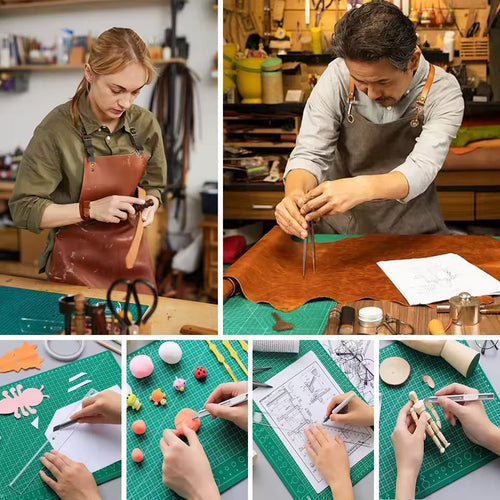Want clean, pro-level cuts on fabric and leather? Learn how to cut fabrics and leather like a pro with a rotary cutter in this guide that even total beginners can follow. Whether you are working on a quilt, patchwork, or a leather DIY, this method gives you fast and clean results. At HandMade Keeps, we help U.S. crafters with the best tools like Patchwork Rotary Cutters, Quilters Cutting Mats, and Quilt Cutting Templates.
Key Takeaways
A rotary cutter helps you cut through fabric and leather quickly with clean edges.
Using the right blade, mat, and ruler gives better control and safety.
This tool is ideal for quilting, sewing, upholstery, and DIY leather projects.
Common mistakes include dull blades and poor pressure control.
By learning simple techniques, you avoid waste and improve your work.
What Is a Rotary Cutter and Why Use One?
A rotary cutter is a handheld tool with a round blade used for cutting fabric and leather. It started in the sewing world in the 1980s and quickly replaced scissors in many workshops. Unlike scissors, rotary cutters glide through materials in one smooth motion.
They are best used with a rotary cutting mat and a clear acrylic ruler for accuracy. A sharp blade gives you precision and saves time. Use 45mm or 60mm blades for heavy fabric or leather. Smaller blades (28mm) help in cutting curves or small patterns.
How to Cut Fabric with a Rotary Cutter Like a Pro
Follow these steps for clean cuts every time:
-
Iron your fabric to remove wrinkles. Align the grain for straight cuts.
-
Place fabric on a self-healing cutting mat.
-
Line up your acrylic ruler. Hold it firmly with one hand.
-
Cut with steady pressure using your rotary cutter.
-
Turn the fabric instead of twisting your hand or blade.
Tips:
-
Use Multi-Craft Fabric Templates from HandMade Keeps to speed up quilt block cutting.
-
For bias edges, cut at a 45° angle.
-
Do not cut more than four layers at once to avoid slipping.
How to Cut Leather with a Rotary Cutter Like a Pro
Cutting leather requires a few extra steps:
-
Choose a 45mm or 60mm blade for better depth.
-
Place the leather on a cutting mat with grip.
-
Use tape to hold leather edges in place.
-
Press firmly and cut in a single motion.
Tips:
-
Soft leather is easier than thick veg-tan hides.
-
A rotary cutter works best on leather up to 6 oz.
-
Avoid fraying by using a fresh, sharp blade.
Rotary Cutter vs. Scissors vs. Utility Knife: What’s Best?
| Tool | Best For | Pros | Cons |
|---|---|---|---|
| Rotary Cutter | Fabric, Leather | Fast, clean cuts | Needs mat |
| Scissors | Light fabric | Easy to use | Can cause fatigue |
| Utility Knife | Thick leather | Heavy-duty cuts | Less precise |
Must-Have Tools for Cutting Like a Pro
To get the best out of your rotary cutter, use these tools:
-
Self-healing cutting mat (18”x24” or bigger)
-
Clear acrylic ruler with non-slip grip
-
Rotary blades in 45mm, 60mm, and pinking edge
-
Skip-edge blades for leather
-
Safety gloves and blade guards
All these tools are part of the Ultimate Bundle of Quilting Guides available at HandMade Keeps.
Common Mistakes When Cutting Fabric and Leather with Rotary Cutters
Avoid these errors:
-
Using dull blades – they drag and tear the material
-
Cutting without a mat – it damages both blade and surface
-
Not pressing the ruler – this causes uneven lines
-
Using the wrong blade for thick leather
-
Cutting the same line twice – this leads to overcuts
Cleaning and Maintaining Your Rotary Cutter
-
Wipe the blade after every use
-
Oil the pivot screw to maintain smooth motion
-
Always retract the blade when stored
-
Replace the blade after 3–5 projects or when skipping starts
Choosing the Right Rotary Cutter for Fabric and Leather
Selecting the right rotary cutter makes a big difference in your results.
-
Blade sizes: 28mm is great for small curves. 45mm is best for general quilting and apparel. 60mm is ideal for thick fabric and leather
-
Handle types: Ergonomic handles reduce wrist strain. Straight handles give more control for tight angles
-
Adjustable tension: Some cutters let you tighten or loosen the blade movement. This helps with different fabrics or leathers
Cutting Curves and Intricate Patterns with a Rotary Cutter
You can cut curves and fine shapes with the right tools and method.
-
Use mini rotary cutters (18mm or 28mm) for small shapes
-
For patchwork and applique, pair your cutter with stencils or cutting dies
-
Leather patchwork is easier with a small cutter and a clear acrylic ruler
-
Go slow on curves. Let the blade do the work
Tips for Beginners Using Rotary Cutters on Fabric and Leather
If you're new to rotary cutting, keep it simple and safe.
-
Practice on scrap fabric or leather
-
Do not press too hard. The blade should glide, not dig
-
Always cut away from your hand
-
Keep fingers clear of the ruler’s edge
-
Using the Quilt Cutting Template – Free Gift Offer helps you start with confidence
Can You Use Rotary Cutters on Other Materials?
Yes. Rotary cutters are versatile beyond fabric and leather.
-
Suitable for: felt, vinyl, cork fabric, fleece, foam sheets
-
Not recommended for: wood, thick cardboard, or heavy-duty canvas
Using the wrong material can dull your blade fast, so always test first.
Safety Tips When Using Rotary Cutters
-
Always retract the blade when not in use
-
Use safety gloves if you’re a beginner
-
Never cut toward your body
-
Keep cutters away from children
Secure your order with Shipping Protection to protect your tools during delivery.
Advanced Techniques: Layer Cutting and Bias Strips
Once you’re confident, these tips will boost your skills.
-
Layer cutting: Stack 2 to 4 layers. Use weights, not pins
-
Cutting bias strips: Lay fabric at a 45° angle using a ruler
-
Avoid stacking leather. Cut one piece at a time
Plan smarter by using the Ultimate Quilt Chart for accurate block sizes and measurements.
FAQs
Can a rotary cutter cut thick leather?
Yes, with a 60mm blade and steady pressure. For very thick leather, use a utility knife.
What blade size is best for fabric?
45mm is the most flexible and works well for quilting and sewing.
How often should I replace the blade?
After 3–5 projects or when cuts start to skip.
Do rotary cutters work on all types of fabric?
Yes, but adjust pressure for light vs. heavy fabrics.
Final Thoughts
Learning how to cut fabrics and leather like a pro with a rotary cutter gives you more control and better results in your craft. Whether you are a beginner or experienced maker, having the right tools from HandMade Keeps makes every project faster and cleaner.
From Multi-Craft Fabric Templates to Quilt Cutting Template – Free Gift Offers, our tools are designed to help crafters across the U.S. create with ease. Visit HandMade Keeps to shop trusted cutting tools, safety gear, and quilting guides built for real results.




